How to buy quality, sustainable clothes that will last
This post is in paid partnership with Organic Basics.
All thoughts and opinions are my own, unaltered and unedited as always. Affiliate links feature throughout.
Fashion’s dirty secret is out. I think we can all agree it’s becoming increasingly difficult for us to turn away from the poor practices that flood the clothing industry.
The effort brands invest in hooking us in to believe we’re a better version of ourselves when we own a closet to rival Cher in Clueless, and we’re wearing the latest trends (which they dictate) has well and truly been exposed via documentaries such as true cost and minimalism. We’re all wising up to the fact that we aren’t the real winners in this, the pockets of the brands we line are. We aren’t the real losers either, the factory workers who have to work in horrific conditions and our environment which is being mined beyond its capabilities are.
This education we’re all receiving leaves us wanting to do better. Unlike the abundance of soulless brands out there, we care. We care about factory workers, we care about our planet and we care about the impact our spending habits cause. Sustainability was a happy side effect of my obsession with capsule wardrobes but over the years, like many of us, I’ve become increasingly passionate about not only ensuring my wardrobe stands the test of time but that it’s also as ethical as it can reasonably be. I use the word reasonably because I believe we can only do our best and no wardrobe is perfect. The point is not to seek perfection but to educate ourselves and to try, without judging ourselves or others too harshly.
Organic Basics is a Danish clothing brand I discovered a few years ago and it’s safe to say sustainability is at the heart of their mission. They’re committed to putting sustainable thinking at the centre of everything which means only choosing fabrics that care for our environment and they only partner with factories that care about their impact too. They’re a brand I admire, one I’m proud to work with and one I think you’ll love too. I’ve been really impressed with the products they sent me to try as part of this post, which I’ll feature throughout, and the pieces I’ve previously owned have all stood the test of time.
Shopping for quality sustainable pieces can be a confusing time consuming process but I’d encourage you to take the pressure off and try to enjoy the slower pace. A change in attitude to shopping is required but there’s so much beauty in slow. As such these are my top tips for buying quality sustainable pieces of clothing that will last based on what I’ve learned along my own journey.
Details are everything
Taking a few minutes to inspect the stitching, zippers and buttons that have been used as well as the feel of the fabric will tell you everything you need to know about the quality of a piece. High quality clothing is put together with the upmost care and time. This is why they often, but not always, cost more than poorer quality pieces. The stitching will be neat and tight, edges will be finished and patterns will always line up correctly. An item will appear balanced on each side, the sleeves will be the same length and the fabric will feel pleasant against your skin. Going over the details with a critical eye will give you a good idea of how pieces will hold up with lots of wear and in the wash. If you’re new to shopping for quality you could always compare a cheaper fast fashion piece with a higher quality piece and play spot the difference. This is a great way to learn on the job.
Check the materials
There are a lot of conflicting messages out there about which materials are best for quality and sustainability. The sustainability space can be a judgemental one which leaves you frozen not knowing what to do for the best. My approach is to simply do your research on the materials used in the items you’re considering. The days of not checking what a piece is made from are long behind me and although it felt like an inconvenience at first, I’m grateful for the knowledge I’ve gained from curiosity. Aiming for organic natural materials where possible is a great start as is recycled. A lot of designers are doing incredibly creative things with recycled lately. Organic Basics uses organic cotton (GOTS), TENCEL and recycled fabrics such as nylon throughout their lines which is hand picked, chemical free and the GOTS ensures the people that made the clothes are paid living wages and treated fairly.
Ask yourself if you can see yourself wearing it over and over.
Opting for classic styles that will transition and stand the test of time is essential when it comes to sustainability. There’s no need to abandon trends altogether if that’s your thing but try to keep trend pieces to 20% of your wardrobe. These pieces won’t last as long and will be are harder to style but pairing them with a solid foundation of quality basics will make them more wearable for longer. Above all, sustainable fashion is about collecting non-disposable pieces that will last. Designers and brands can do their best when it comes to materials and factories but unless they’re creating pieces destined to be heirlooms as opposed to landfill the over production problem will remain. Our responsibility as consumers in this cycle is to think before we buy. My favourite trick here is to mentally fast forward to next year and ask myself if I can still see myself wearing the item, then I fast forward another 5. The longer I can see myself wearing something the better.
Research manufacturing processes.
This sounds a lot more labour intensive than it actually is. Companies who are working with certified ethical factories will want to tell you all about it so the information will likely feature on their website. If not, a quick google will usually throw up the answers you’re looking for. It’s becoming increasingly difficult for brands to greenwash or hide their practices from consumers so this information is easier than ever to get hold of. The more details there are about the factories the brand you’re looking to purchase from are using the better. Organic Basics features their locations, how many hours the employees work, vacation allowance, certificates they hold and whether they’re family run. This kind of research (which shouldn’t take much time) helps to ensure we’re supporting brands who care about how their products are made and we can feel good about knowing exactly how our money is being spent and who is benefiting from our purchases.
Quality doesn’t always equal cost
Quality sustainable clothes should cost more money because of all the reasons listed above but don’t fall into the trap of thinking quality clothes have to cost a fortune because they don’t. The old saying you get what you pay for definitely rings some truth but this isn’t a never ending scale. You get what you pay for to a certain extent but it’s important to be conscious that we’re always paying for something. For example this could be living wages for factory workers, slowly sourced materials that respect the planet, a highly skilled experienced designer’s time or higher quality materials. The important thing to remember is that a brand always makes a profit, they have to in order to survive. If brands are selling cheap pieces this means someone somewhere is always losing out. The consumerism trick here of course is when pieces are of poor quality we require more of them and as a result we end up spending more than if we’d bought the one higher quality more expensive piece. Owning fewer quality pieces has without a doubt saved me a fortune over the years but it took a while for me to get my head around this and prove it to myself through spending tracking.
Changing the way we shop isn’t an easy process but on the other side is a lower carbon footprint, a wardrobe to cherish and the peace of mind that comes from knowing you’ve voted with your wallet.
Big thank you to Organic Basics for sponsoring this post. You can find out more about the wonderful things they’re doing in the world and their products here. If you do decide they’re for you they’re kindly offering a 10% discount when you use the code JESSICAOBX at the checkout.
How are you combatting fast fashion? Have you got any more tips to share? Let me know in the comments.













